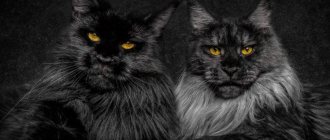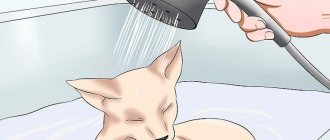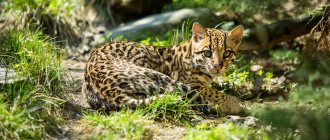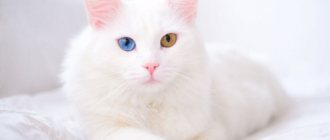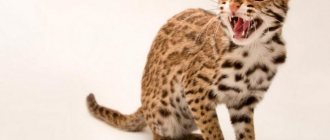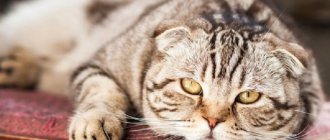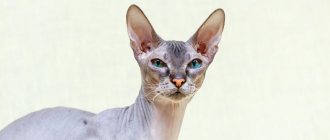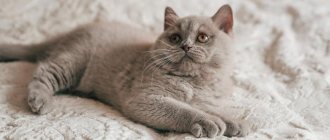History of the Ocicat breed
Despite the strong external resemblance to the ocelot, Ocicats are not related to wild cats.
The breed was born in the American state of Michigan in 1964, and completely unplanned. It all started when felinologist Virginia Dale wanted to breed a Siamese cat with tabby fur. To implement her plan, the breeder crossed a Siamese with an Abyssinian, and then performed the reverse operation and mated the mixed breed born from this couple with another Siamese cat. However, something in the genetic code of the embryos went wrong, and, along with the tabby babies, the breeder's fluffy ward brought an unusual cream kitten, strewn with contrasting spots. The newborn cat was named Tonga, castrated on time and put up for sale for a symbolic ten dollars. Dale herself temporarily said goodbye to the dream of tabby Siamese, completely concentrating on breeding a new breed of spotted cats. A few months later, Tonga’s parents gave birth to another ocelot-colored baby, Dalai Dotson, to whom the felinologist was more attentive. As a result, the cat received registration with the CFA and managed to participate in the breeder’s breeding experiments.
Between 1966 and 1980, just under a hundred spotted kittens were born in the United States, and this happened to other owners - Mrs. Dale herself temporarily retired. At first, only Abyssinians and Siamese were involved in the process of creating the breed, but later American shorthair cats were involved in the matter, bringing silver tones to the color of Ocicats. In 1986, the “Michigans” were officially recognized by the CFA, issuing a ban on their further crossing with genetic relatives – Siamese, Abyssinian and American Shorthair cats.
Note: Not all modern Ocicats are born spotted.
From time to time, so-called breed varieties are born - individuals with a constitution that meets the standard, but with an unusual coat color, in which contrasting marks are either completely absent or merge with the background.
Characteristics of this breed
A cat produces 5-6 kittens.
The animal has certain characteristics. Therefore, a potential owner needs to study the characteristics of the breed in order to decide whether to buy such a cat or not.
Shedding
Molting occurs in spring and autumn. In short-haired pets, the hair falls out in separate hairs. It is difficult to remove it from furniture and carpets. Simplifies the process of combing out dead hairs with a slicker brush. It is convenient to use a brush-glove.
Allergy
Microscopic particles of fur are constantly present in the air and fall on the mucous membranes of the nose and eyes, causing irritation.
This breed was developed by crossing Siamese and Abyssinian cats, but a little later, due to an error in the documents, the American Shorthair was added. As a result, Ocicats differ:
- lively temperament,
- vitality,
- courage,
- love of communication, both with other pets and with people.
They are more reserved in character compared to Siamese cats:
- undemanding
- flexible,
- patient,
- very calm.
Ocicats are also distinguished by their special obedience to their owners, so they quickly arouse the sympathy, approval and favor of not only their households, but also their guests.
Animals of this breed love to accompany their owners during walks and travel, even easily agreeing to be on a leash and wearing a collar. A traveler, a true friend - these are the distinctive character traits of any Ocicat.
The predatory appearance of this animal is deceptive. The Ocicat is a cat whose character will appeal to all lovers of these pets: both experienced and beginners. This is an affectionate and friendly four-legged friend, perfectly adapted to living near people. The Ocicat cat, a photo of which you can see in this article, is smart, quick-witted, and sometimes cunning.
Ocicat breed standard
The breed owes its bright, wild charisma to its exotic color and athletic build, thanks to which all Ocicats successfully “mimic” their distant relatives of the leopard. Cats are almost always smaller than males, but their grace is purely external. Any Ocicat, whether male or female, is far from an ascetic pet, as it might seem at first. Spotted “girls” weigh from 4 to 5 kg, “boys” can “pump up” muscle mass up to 7 kg. At the same time, visually both give the impression of very light, graceful creatures.
Head
Ocicats have broad, wedge-shaped faces with a faintly defined stop, a slight curve between the cheeks and chin, and a prominent whisker break. If you look at the animal in profile, its head seems slightly elongated, while in the full-face position the muzzle has a square format. Ocicats' chins are well developed, their jaws are strong, and their necks are elongated and flexible.
Ears
The ear flap is of medium size, in a permanently “alert” position. The correct fit of the cartilage is considered to be one in which an imaginary line drawn along the cat's forehead intersects the ear at an angle of 45°. Additional nuance: if two Ocicats with the same exterior are exhibited in the ring, but one of them has lynx tufts growing on the tips of his ears, preference will be given to him.
Eyes
The breed is characterized by large, almond-shaped eyes with outer corners raised to the temples. The second mandatory requirement of the standard is the distance between the organs of vision exceeding the length of one eye. The color of the iris is not tied to the suit and can be anything, with the exception of a blue tint.
Frame
The CFA describes Ocicats as cats with a long, yet dense and athletic body. At the same time, any hint of a rough constitution and clumsiness of movements is excluded and considered as a vice. The chest should be spacious and wide, the back should be straight or barely raised in the area between the croup and the lower back. Muscular and flexible individuals with straight lateral lines are considered ideal representatives of the breed.
Limbs
The Ocicat's legs are muscular, powerful and moderate in length. The cat's feet are compact, tending to an oval shape and having five toes on the front paws and four on the hind paws.
Tail
All representatives of the breed have long tails of moderate thickness with a slightly pointed tip covered with dark hairs.
Wool
Ocicats are dressed in smooth, shiny “coats” consisting of short and thick hair. The coat should fit snugly to the body, but not fluff or bristle.
Color
Even experienced breeders are not always able to immediately characterize the spotted color of an Ocicat as “meeting the standard” or “defective”. In total, felinological associations identify 12 “correct” colors of the breed, differing from each other in the contrast of the background and markings. Among them:
- brown;
- chocolate;
- reddish brown;
- lilac;
- blue;
- yellow-brown;
- chocolate silver;
- black and silver;
- beige-silver;
- blue-silver;
- brown-silver;
- lilac-silver.
According to the standard, each hair must have a ticked (zoned) color. As for pseudoleopard marks, they appear where some of the tips of the hairs are tinted dark, and some are light. On the body of the Ocicat, both relatively light areas (lower jaw, area around the eyelids, chin) and dark ones (end of the tail) are also noticeable.
The brightness of the markings themselves also varies. For example, the spots on the face, paws and tail are darker than the marks on the body. The smearing of the coat pattern and its fading are positioned as defects in the exterior, therefore, at exhibitions, cats with such defects are given a lower rating.
How are dark spots located on the body of an Ocicat?
Each purebred Ocicat has stripes on its face in the shape of the letter “M”. Oval spots begin to appear in the area between the ears, turning into a small “scatter” in the lower part of the neck and shoulders. In the vertebral zone, running from the shoulder blades to the tail, the marks are arranged in horizontal rows, with large strokes of spots alternating with contrasting dots. On the hips, belly and shoulder blades of Ocicats, markings are scattered chaotically. There are dark finger-shaped “traces” on the sides. In the lower part of the legs and on the throat, the spotted pattern gives way to a “bracelet” pattern, and the larger the gaps between the ends of the “bracelets”, the better.
The Ocicat's eyes have a black rim surrounded by light background colored fur. The tone of the tail deserves special attention, which in controversial cases is a defining feature of the breed. In purebred individuals, the tails have contrasting transverse stripes, but the tips are colored in a uniform dark tone.
Disqualifying faults
- The presence of a white medallion or spot (does not apply to white hair around the eyes, on the throat, chin, nostrils, as well as to the white background in silver-colored individuals).
- Deformed tail with creases.
- Blue iris.
- The number of fingers is more or less than specified by the standard.
- Coat of red, cream and torby colors.
- Long fluffy hair.
Color
Experts distinguish 12 color types of Ocicats. Many people who are far from felinology cannot discern all the nuances.
- Red-brown. Black or dark brown spots are scattered throughout the brick-bronze tone. The main wool is not monochromatic, but has a natural fine agouti pattern, in which each wool has several zoned differently colored stripes.
- Chocolate. Light ivory agouti has chestnut spots. The tip of the tail is the same color.
- Blue. The spots and cap on the tail are gray-blue, the body is colored a pale yellow or bluish agouti shade.
- Lilac. Purple spots are scattered on a pale yellow or milky background.
- Yellowish brown. The main color of the coat of the yellow-brown Ocicat Agouti is ivory, the pattern on the body is sandy-ocher.
- Silver-black. Perhaps the most contrasting of all colors. Black or dark gray spots and stripes decorate the silver or white agouti base coat.
The remaining variations differ only in the color scheme of the design on a white background:
- Silver chocolate. The spots and tip of the tail are chocolate-colored.
- Silver-brown. Cinnamon color drawing.
- Silver blue. The spots and tip of the tail are blue.
- Silver-purple. The color of the pattern is lavender-lilac.
- Silver beige. The spots, half rings and cap on the tail are a delicate fawn color.
Character of the Ocicat
The Ocicat is a breed for those who need an affectionate and sociable pet with the appearance of a wild native of the savannah. Despite their somewhat bestial appearance, Michigan cats are quite good-natured, and in their desire for communication they are completely reminiscent of dogs. If there is a noisy party in the owner’s house, you can be sure that the cat will have time to get to know each of its participants, and will also gain the trust of individual comrades.
Usually the process of establishing contacts with strangers among Ocicats goes like this: hiding behind the sofa (for a very short time), carefully sniffing and licking human palms, and, finally, a sudden jump into their arms. By the way, the latter may not happen - cats are sensitive to other people’s moods and will never try to hug emotionally unstable people, as well as those who are cool towards animals. So if catofey defiantly avoids the knees of one of your friends, you should think about it. The trademark unexpected “bite” from an overabundance of emotions can also occur, and it should be taken condescendingly - in this regard, Ocicats are no different from their mongrel relatives.
As already noted, the Michigan cat’s habits resemble a dog, and a very nimble one that cares about everything. Each purr satisfies its own curiosity in a different way, but usually not a single cat will pass by an unlocked kitchen cabinet or a slightly open dresser door. Moreover, it makes absolutely no difference to the Ocicat whether the owner hides the dream of all mustachios - valerian - in these storage facilities or simply stores waste paper. Opening the door and making any secret public is normal for the breed.
If the Ocicat wanted something, he will get it, and if the person does not give it what he wants, the cat will take it himself. This behavior applies not only to treats hidden in the far corner, but also to completely inedible objects. By the way, the Ocicat is a breed for which it is better not to delay lunches and dinners. A hungry pet will not languish in anticipation, but will find and open the bags with “drying”, not forgetting to inspect the saucepans standing on the stove.
True Ocicats are travelers at heart. Unlike most representatives of the cat family, they are not fanatical about their attachment to a particular home, so they can easily endure moving. True, it is better to transport a purring tourist in your own car - a carrier, and in general the breed quietly hates any space limiters.
Attitude towards family members
The Ocicat cat is a very loving person. When she has a need for affection, she will declare this very persistently, and will literally “kiss” her owner. Both children and elderly people love these cats. For old people, they are irreplaceable listeners and interlocutors. For children - the best companions for outdoor games and pranks.
There is another interesting feature of the Ocicat’s character that distinguishes it from its fellow tribesmen - it treats strangers without the usual cat-like wariness. If a cat likes a guest, he will immediately demonstrate it: he will offer to play, and he will jump on his lap in anticipation of affection.
Education and training
It is customary to write about the learning abilities of Ocicats only that they are smart and quick-witted pets who can easily fetch objects and simple acrobatic tricks. At the same time, it is extremely rare to find information that, like any cats, the descendants of Siamese and Abyssinians are not eager to obey a person and train simply because the owner demands it.
If you decide to get serious about training your Ocicat, come to terms with the need for compromises, which you will have to make often. Some breeders generally recommend relying on the inclinations of the breed, since by stimulating the cat to do what he obviously likes, you dramatically increase your chances of success. For example, Ocicats love to jump, which means that it will not be difficult to teach your pet to take small barriers and fly through a hoop.
The Ocicat has a good memory and excellent self-learning abilities, inherited from the Abyssinians, so the cat quickly learns a list of basic commands. In order for your pet to learn to comply with the requirements “Come to me!”, “Sit!”, “Stand!”, a classic training program is sufficient. Special literature, for example, the book “Training a Cat in 10 Minutes” by Miriam Fields-Bambino or “How to Train Your Cat” by Ellis Bradshaw, will also help you broaden your horizons and learn new techniques for effectively influencing an animal.
Raising a small kitten is easier when a trained adult cat already lives in the house. Submitting to the animal hierarchy, the baby mirrors the behavior of an adult comrade and makes fewer mistakes. If the Ocicat is the only pet in the apartment, the owner will have to take on the role of mentor. As for toilet training your pet, there are no difficulties here. Michigan cats are naturally clean. If there is no usual litter box nearby (for example, on the road), they prefer to be patient or persistently remind them of their needs. Ocicat kittens brought to a new home also quickly get used to the bath with filler and willingly scratch themselves in it, hiding traces of “wet deeds.”
Maintenance and care
A curious and restless Ocicat needs to be provided with enough toys so that he does not use your favorite souvenirs instead. Moreover, the shopping list should include not only balls and wind-up mice, but also complex cat puzzles, which the breed loves. A tall gaming complex will also not be out of place - in his spare time, the spotted extrovert loves to transform into a conqueror of mountains and a spy who suddenly emerges from a plush “apartment.”
In addition to toys and food bowls, the Ocicat will need to be provided with a scratching post and a tray. Some breeders recommend setting up two trays for one individual at once, since the breed is extremely clean and does not like to go into litter, which even smells slightly. At the same time, plastic baths should be placed as far as possible from the feeding area: for cats, “dining room” and “toilet” are incompatible concepts.
Locking an Ocicat within four walls for fear that a rare cat will be stolen or that it will get lost is wrong. You can and should walk your pet, but it is better to control its movement outside the home using a harness. The purr will not run away of its own free will, but if it notices a dog nearby, it may become nervous and begin to seek refuge in the trees.
Hygiene
As for hygiene procedures, everything is elementary here - the Ocicat does not need to be combed endlessly, pouring liters of conditioners and other cat cosmetics on it. Once a week, it is recommended to walk over your pet’s body with a brush or rubber mitten, and then rather with the aim of collecting dead hair and massaging the skin, rather than for the sake of full combing.
The Ocicat's ears are cleaned as needed, but you should definitely look inside the ear funnel every few days. For hearing hygiene, regular pharmaceutical compounds like Cliny, Hartz and a soft piece of textile or a cotton swab are suitable. Ocicats have problematic teeth, with a predisposition to the formation of tartar, so they need to be brushed daily. To do this, you will have to purchase a cat toothbrush with massage spikes and toothpaste.
If your cat puts on a “concert” while cleaning your mouth, try replacing the traditional toothpaste with a product called a liquid toothbrush. This veterinary solution for removing plaque on teeth is added to a bowl of drinking water and works when the animal comes to drink. At the same time, owners of animals with sensitive immunity and allergies should not get carried away with such products and consult a veterinarian before using them.
Feeding
A healthy Ocicat with the same appetite absorbs both high-quality “dry” super-premium and holistic classes, and natural food. The latter concept does not mean dishes from the master's table, but a standard set of products useful for any domestic carnivore. This is, first of all, lean meat and offal (up to 70% of the total serving volume), low-fat fermented milk products and boiled sea fish without bones (no more than twice a week). Of the cereals for cats, rice is the most harmless. Vegetables include carrots and pumpkin. Once a week, the cat can be treated to a chicken yolk or a whole quail egg.
Since Ocicats have problems with their teeth and gums, from time to time the animal needs to be given something rough to chew, for example, poultry and beef cartilage or sinew. In addition, purchased vitamin complexes with taurine will have to be introduced into the natural diet, the lack of which negatively affects the vision and general immunity of the breed. Ocicats eat willingly, do not refuse supplements, and do not suffer from a tendency to obesity. However, overfeeding animals, especially spayed and neutered ones, is harmful. An Ocicat will never look like a ball-shaped fluffball, like, for example, a British cat. His lean constitution is the result of a complex game of genes, against which it is at least pointless.
Health and disease of Ocicats
Despite the fact that the Ocicat is an artificially bred breed, its representatives are in good health. With proper care, Michigan cats live up to 15-18 years, although felinologists assure that such an age limit is far from the limit. As for genetic diseases, the probability of their inheritance is not one hundred percent. Some pathologies of Siamese and Abyssinians pass to Ocicats unchanged, and some are autosomal recessive (when the pet is a carrier of a defective gene, but does not suffer from the disease itself).
The most unpleasant diseases that an Ocicat can get from its ancestors are renal amyloidosis and erythrocyte pyruvate kinase deficiency. In the first case, the symptoms are sudden weight loss, constant thirst, problems with urination, in the second - decreased appetite and increased abdominal volume. Often illnesses occur without visible symptoms, so you should keep an eye on the pulse and visit the veterinarian at the slightest change in your pet’s behavior.
Siamese have given Ocicats a tendency to develop hypertrophic cardiomyopathy. In addition, representatives of the breed are carriers of the recessive gene for retinal atrophy, transmitted from producers to offspring. So, when buying a kitten in American nurseries, feel free to ask the seller for the results of examining the litter for a predisposition to this disease - testing for the detection of genetic retinal atrophy in the USA has been carried out for a long time and successfully.
Where to buy and how much does a kitten cost?
The breed remains rare.
The Ocicat is a breed that can cause allergies.
You can purchase a purebred animal from a nursery that specializes in breeding Ocicats. Unregistered breeders, whose advertisements can be found on the Internet, most often offer animals with an admixture of other blood or those that are similar in appearance to the breed.
When buying kittens, they study the pedigree of the parents. It is useful to see adult cats. You should purchase the largest kitten from the litter. The animal chosen is active, moderately well-fed, with a beautiful pattern and proportional build.
Lethargic kittens, excessively fat and incorrectly folded should not be sold.
After acquisition, the animal must be shown to a veterinarian. A specialist will assess the kitten’s condition and, if necessary, advise how to care for it, taking into account the pet’s individual characteristics.
If it is determined that the animal has been sick for a long time, that is, it was sick even before purchase, the person has the right to return it to the breeder who did not warn about the health problems of the selected kitten.
When buying kittens, they study the pedigree of the parents
Pedigree animals cost from 40 thousand rubles.
How to choose a kitten
- Make sure that the color of the animal matches the shades specified in the standard. If the seller offers a spotted kitten of any unticked color, it is anyone but an Ocicat.
- The champagne shade, as well as the silver-blue, silver-lilac and fawn-silver colors are considered the rarest, so you will have to pay more for an Ocicat of this color.
- The most common colors of the breed are all shades of chocolate. So, when buying a brown cat, you can count on a small saving - the price tag for blue and lilac cats is much higher.
- If the character of the Ocicat is important, and not its exhibition career and breeding characteristics, you can opt for varieties of the breed - cats with ticked fur without marks, individuals with solid colors in which the spots merge with the background, and beauties in marbled “fur coats” (those Aztec cats).
- Pay attention to the behavior of the kittens when you arrive at the nursery. If babies hiss, run away and do not come out of hiding for a long time, this indicates instability in the psyche of the offspring, which is most likely inherited from their parents.
Breeding
Ocicat cat with kittens
Breeding the Ocicat breed is successful with the right choice of mating partners. Pedigree cats have retained their animal maternal instinct, and the breeder hardly needs to help them take care of the kittens. Full-fledged offspring are obtained from cats from 18 months.
When choosing a partner, their compliance with breed standards, age, mating experience and health are taken into account. You should not bring together a cat and a cat for whom mating is the first.
Failure to meet standards, being too young or too old, and health problems are reasons for culling. It is unacceptable to breed cats from a bloodline.
Mating is preceded by violent games, during which the cat chases the cat with loud screams. When a female is overly aggressive towards a male, they are separated into different rooms for several hours, and then the attempt is repeated.
Be sure to read:
The Ural Rex is a Russian aboriginal breed of curly-haired cat with curly hair.
Pregnancy and childbirth
Pregnancy lasts 2 months. A cat produces 5-6 kittens. Complications at the stage of bearing offspring and during childbirth usually do not occur in the animal. It is advisable to show your cat to a veterinarian before lambing.
Ocicat price
In Germany and the rest of Europe, the cost of a breed Ocicat varies from 800 to 1,500 euros (approximately 55,000 - 100,000 rubles). To purchase a kitten in its homeland, the USA, you will have to spend about 500-800 dollars if the animal has a good exterior, and about 150 dollars if the animal has minor defects in appearance and one of the most common coat colors. In Russia, you need to look for Ocicats from breeders involved in breeding rare and exotic cats - single-breed nurseries in the country are still in great short supply. The approximate cost of a pet-class kitten with documents and a clean pedigree from domestic sellers is 35,000 rubles and more.
Price and purchasing recommendations
The breed is in great demand in our country. The price of an Ocicat kitten is quite high, therefore, when choosing a pet, you need to be careful in order to purchase a purebred and healthy animal.
A decent breeder will not sell kittens that are not yet 2.5 months old. Until this age, the animal has not yet developed the skills of independent living and cannot use a tray or scratching post. It is also necessary to check the passport, which contains notes on the vaccinations received. In addition, the pet must undergo deworming. Such a document is drawn up in accordance with international standards.
The Ocicat is an elite, rare and expensive cat breed. In our country, only a few nurseries are engaged in their breeding. The minimum cost of a kitten of this breed is 30,000 rubles. If the cost is lower, this should raise questions about the kitten's compliance with the standard.
A properly raised animal has a good-natured and affectionate disposition. If you follow the rules of care and feeding and undergo periodic examinations by a veterinarian, your pet will delight its owners with its intelligence and activity.

